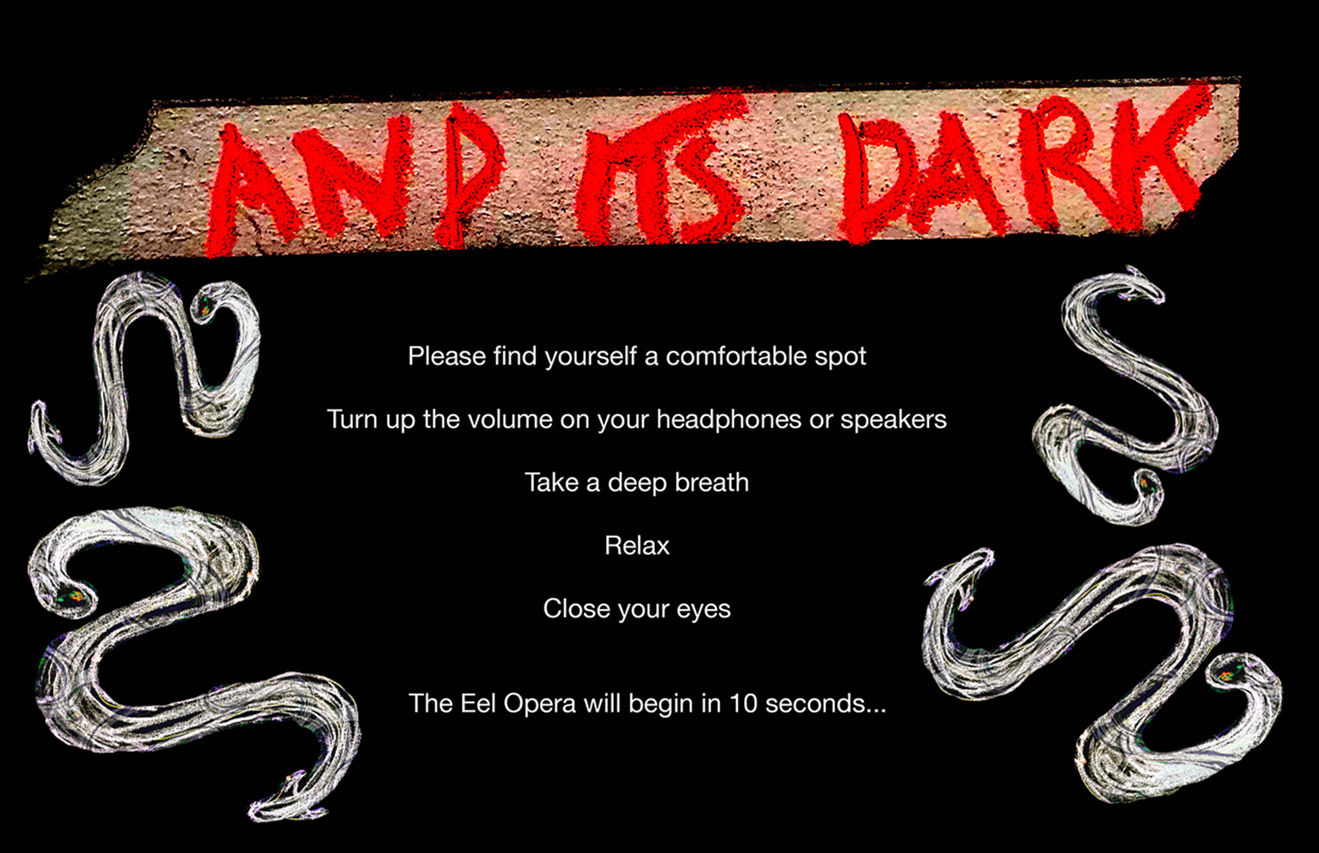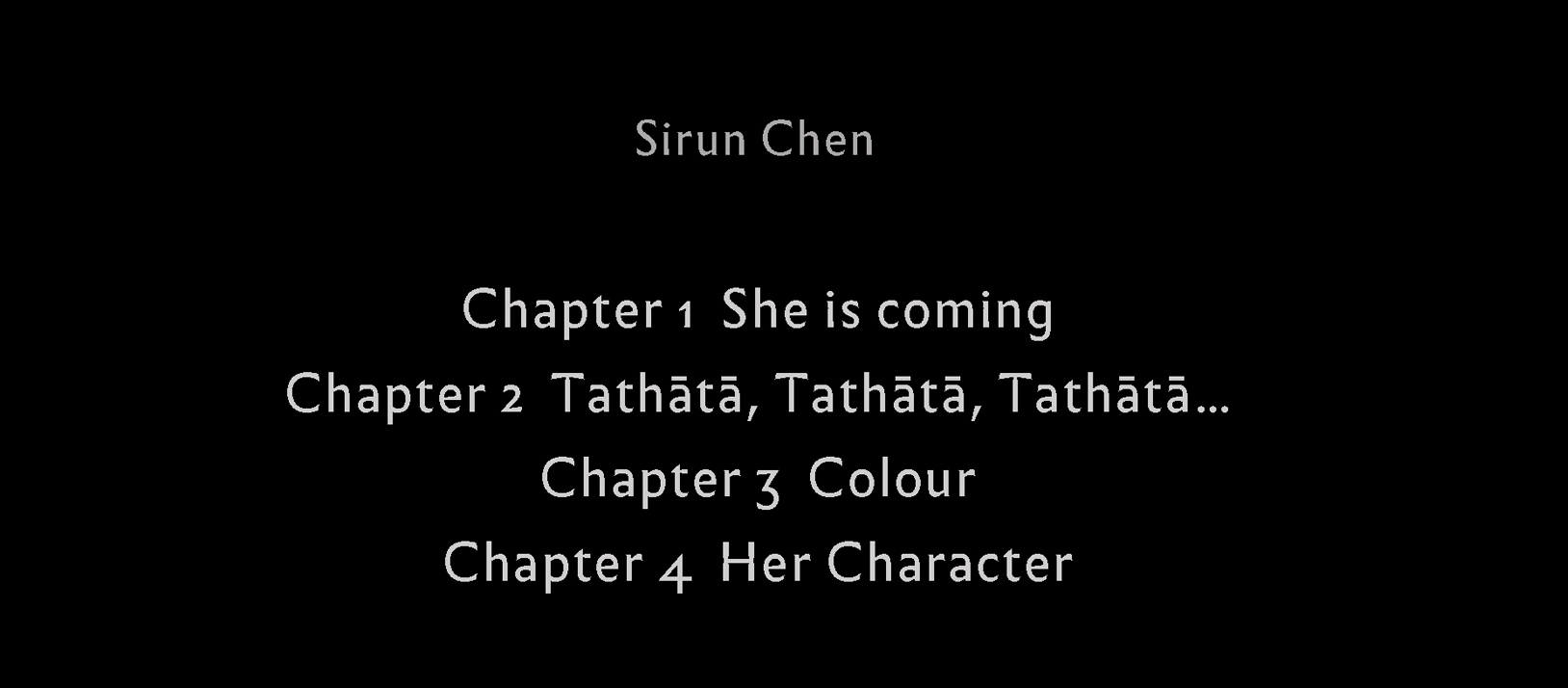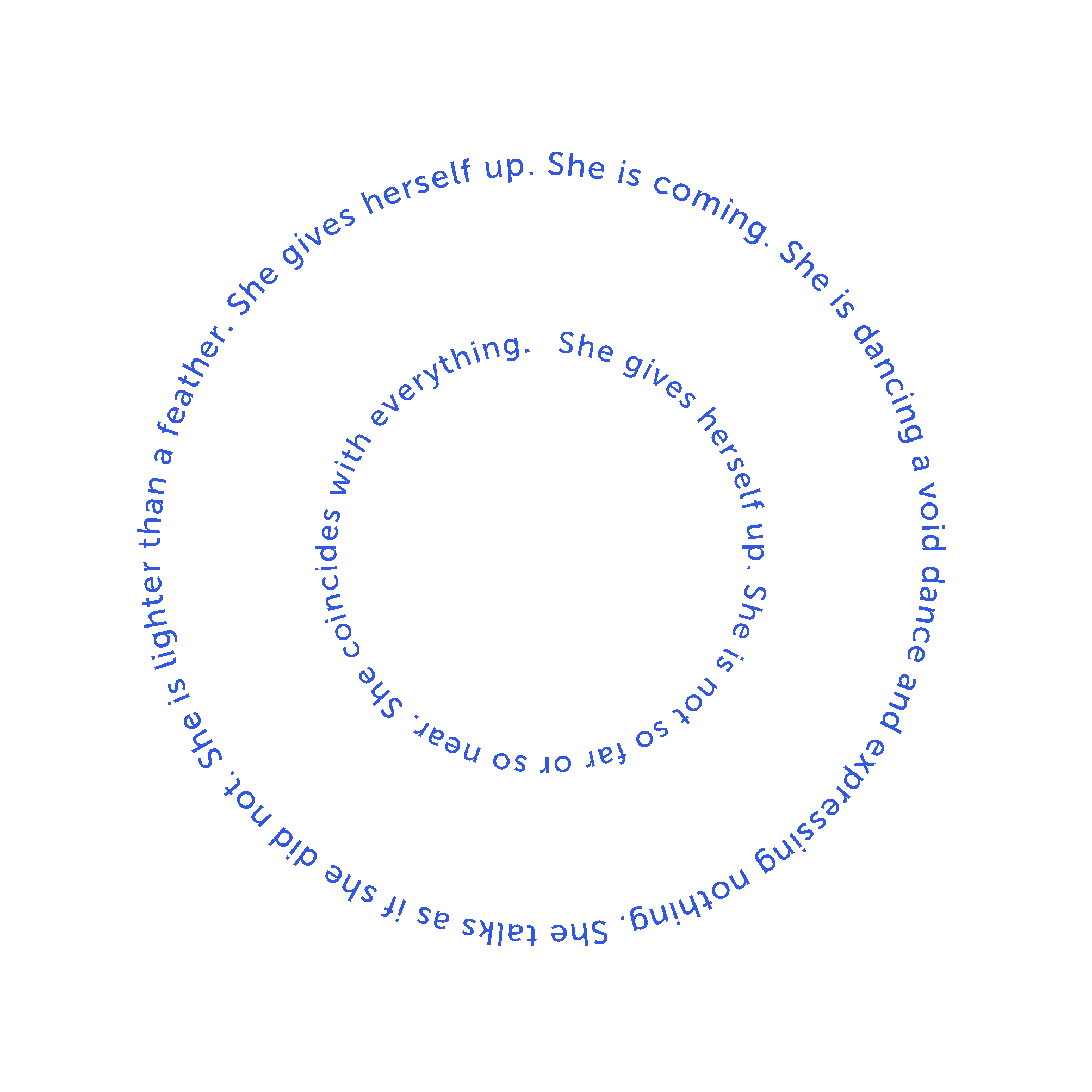Volume 1
An Ecology of Many Worlds
Over fifteen months of the MA Art & Ecology, this first
cohort have developed compelling bodies of artistic work and deep
understandings of how ecological thought is situated, historical and embodied.
While the ‘Man’ centred within imperial ecology still looms large in mainstream
environmentalism, the sensibilities that emerge here are migratory, queer,
feminist, working-class, butch, sensitive and enraged. There is a striving to
decolonise, to heal and reconnect, grounded in awareness that the commons is
not only that which historically has been marginalised or dispossessed, but
that it encompasses the planetary commons – earth, water, air – that binds us
all. Commoning, therefore, is understood as a fundamentally contemporary
strategy of survival and flourishing – to be found in recipes passed across
generations, in folklore re-animated with a flash of neon, in digital
dissemination and forms of occulture. While informed by a pluriverse of theory,
there is a profound attention to the somatic and the everyday, to fermenting
transformations that hone sensory acuteness and call for new descriptions of
the sensorial world.
The artists gathered here recognise artistic materials not
only as political in relation to the human labour involved in their production,
but also in terms of their sustainability and cultural significance. They have
investigated the extent to which the entities that materials derive from – be
it mineral, animal or plant – are gathered with care and reciprocity, recalling
Robin Wall Kimmerer’s account of the ‘honourable harvest’, or are manufactured
through systems of extraction enabled by a colonial mindset. Material
afterlives is a crucial theme, and understanding how, as Max Liboiron argues,
pollution is colonialism, has been essential.
There are difficult reckonings
with inheritance – who benefits? who is dispossessed? what are the
possibilities for justice given enduring inequities? But afterlives can take
other paths to denaturalise extractivism, with practices of investigation,
attention, gleaning and repurposing that may enact a re-enchantment, focus
attention on what has been lost, or imagine how things might be otherwise.
Might a product made from timber be understood to retain within it the spirit
of a tree? As the sixth extinction unfolds, these artists find themselves using
their creative powers to reimagine relations with the more-than-human world, to
rage but also to organise, to recognise the resistance of matter and the power
of joy, to hold a space for that which does not speak, to whisper with ghosts
and dragons.
Ros Gray
Programme Director, MA Art & Ecology
Back
Fatima Alaiwat
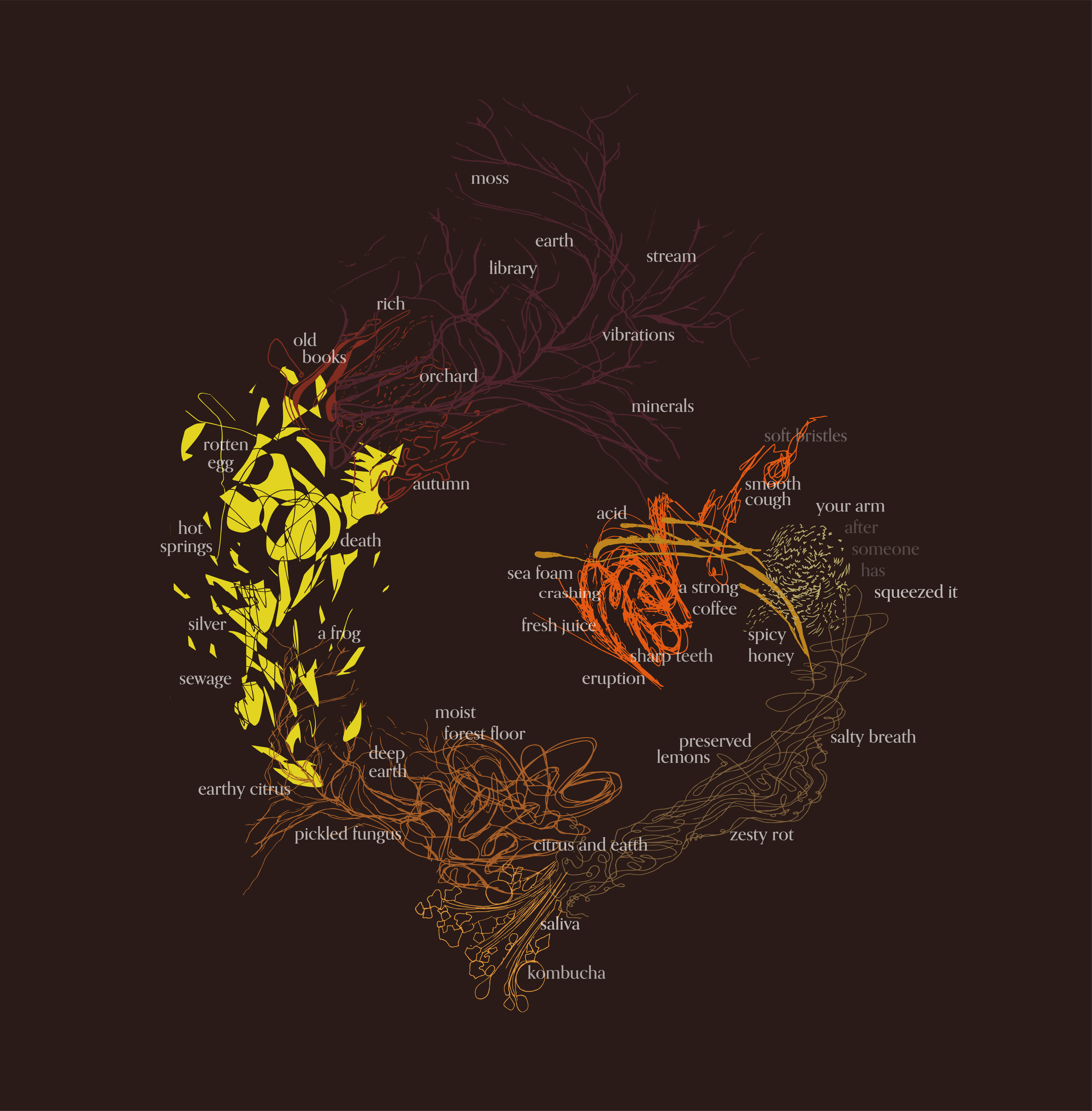
compos[t]ing rhythms with
bokashi
Over the past year, I have developed a bokashi practice - a
method of fermentation-composting - centred around the composting of orange
peels. This has involved being enveloped in various transmutations and
intoxicating citrusy events. My contributions to this process have included
ripping fresh peels into the bin layered with bokashi bran, burying fermented
peels in soil, and attuning my senses to the wafting scents of hot soil, fungal
aromas and decayed oranges. Performing the various tasks needed to sustain the
bokashi released worlds of ‘sensory events’ that ruptured and permeated my home
space - like the arrival of guests or seasons that would last for days or weeks
in various volumes - my awareness dipping in and out with their shifts and
intensities.
The image above represents a compilation of sensory events, constituting a host of entangled, overlapping, tangential and spiralling connections. With the awareness that ‘what soil is thought to be affects the ways in which it is cared for, and vice versa, modes of care have effects in what soils become’ (Bellacasa 2017, 170), I question how sensory intimacy with composting might serve as a way to lay down, cultivate and transform stories of belonging, whilst also practically improving the quality of soils that physically nourish our bodies.
The composting process is one that involves constant tinkering and amending: much like a recipe yet, in the case of bokashi, it is never complete. As a regenerative process, bokashi exists in constant cyclical rhythms. When the bokashi soil became too wet, I added cardboard and leaves. When there were too many pot worms, I added egg shells. The more we are required to tinker, the more we extend knowledge and experience, with potentially transformative effects on how we relate to waste, materiality and the spaces we inhabit. This continuous practice invites us to think about human engagement as a part of nature. There is no outcome, but a continuous process of seeking balance.
This embodies a key modality in my practice: a fascination for exploring dynamics of cyclical activations within the everyday, relating with our biological survival. This has continued to guide me towards the realms of the intimate, somatic, sensuous and body-centred ‘re/skilling’, as both practical and poetic modalities for exploring belonging and healing - or rather, ‘harm reduction’ (Kinnunen 2021) for alienated bodies, as well as quieter modes of resistance in the face of geopolitical issues and environmental crises.
Sandor Katz suggests that one of the most damaging aspects of our dominant food system is that it ‘deskills and disempowers peoples, distancing us from the natural world and making us completely dependent on systems of mass production and distribution’ (Katz 2020, 18). Optimistically, I question if cultivating more body-centred senses of belonging reskills us in earth-based epistemologies, that feel pertinent to building resilience in the face of environmental crises and fragile global food systems. Slowly, we ferment radical intimate relations with and in the homogenous and global.
Intimacy is an important and grounding aspect of my working process. I investigate how non-normative bonds with the more-than-human might facilitate accessible polycultures of knowledge, and provide alternative approaches to climate justice to that of the technocratic and scientific, despite dispossession. In his essay On Intimacy with Soils, Devon Peña talks about how his grandmother’s relationship with soil ‘encouraged are-membering of the body by means of affiliation with the land’ (Peña 2019, 277) and allowed her ‘to develop a deeper, more relational sense of place…[and] sense of partnership with the soil despite being far removed from any ancestral lands’ (Peña 2019, 277-278). When land is not owned and/or not home; how might we facilitate connection through caring for earth? I wish cultivating intimacy within small-scale, domestic composting as a way to foster a form of access and connection to land for alienated bodies, with the view that ‘the opposite of dispossession is not possession. It is not an accumulation. It is unforgetting. It is mattering’ (Morrill et al. 2016, 2). How can mattering be understood through bokashi as we reclaim soil relations through co-production in our home?
To be intimate with waste and microorganisms, as I propose with bokashi, opens a particular territory of reconfiguring relations with industrial food systems and the non-human, as a way to ‘craft new imaginaries for knowing, living and being with waste’ (Kinnunen 2021, 79). Caring for waste and, furthermore, sharing space in the home resists attitudes of ‘distance, disposability, and denial’ (Hawkins 2006, 16). How can this offer a way to shift understanding of belonging withand as part of nature, rather than within human social structures - particularly when social structures are ‘hostile to any attempt to put the individual back where he belonged’ (Fanon 1964, 53)?
How can a better representation and reverence for embodied knowledges serve to resist dominant capitalist, consumerist, colonial structures by seeking to attune with other forms of knowing, living, relating and learning? I question how ‘bring[ing] cognition down to earth’ (Mol 2021, 28) might better address complex issues that stem from such structures, by seeking to get closer to embodied and non-verbal forms of human intelligence. I do not propose this as a direct alternative to cognitive and intellectual modalities, but rather to think with how ‘the intellectual monoculture of science will be replaced with a polyculture of complementary knowledges’ (Kimmerer 2013, 139).
I wish to connect these words with the sensory events shared in the initial image compilation. Through personal experiences of living with bokashi in my home, I examine the intersection of probiotic, composting and embodied methodologies. Though the events were varied and extended to broadly embodied relationships, for the purpose of this writing, I focus primarily on scent and touch, as predominant features of living and relating with bokashi.
The image above represents a compilation of sensory events, constituting a host of entangled, overlapping, tangential and spiralling connections. With the awareness that ‘what soil is thought to be affects the ways in which it is cared for, and vice versa, modes of care have effects in what soils become’ (Bellacasa 2017, 170), I question how sensory intimacy with composting might serve as a way to lay down, cultivate and transform stories of belonging, whilst also practically improving the quality of soils that physically nourish our bodies.
The composting process is one that involves constant tinkering and amending: much like a recipe yet, in the case of bokashi, it is never complete. As a regenerative process, bokashi exists in constant cyclical rhythms. When the bokashi soil became too wet, I added cardboard and leaves. When there were too many pot worms, I added egg shells. The more we are required to tinker, the more we extend knowledge and experience, with potentially transformative effects on how we relate to waste, materiality and the spaces we inhabit. This continuous practice invites us to think about human engagement as a part of nature. There is no outcome, but a continuous process of seeking balance.
This embodies a key modality in my practice: a fascination for exploring dynamics of cyclical activations within the everyday, relating with our biological survival. This has continued to guide me towards the realms of the intimate, somatic, sensuous and body-centred ‘re/skilling’, as both practical and poetic modalities for exploring belonging and healing - or rather, ‘harm reduction’ (Kinnunen 2021) for alienated bodies, as well as quieter modes of resistance in the face of geopolitical issues and environmental crises.
Sandor Katz suggests that one of the most damaging aspects of our dominant food system is that it ‘deskills and disempowers peoples, distancing us from the natural world and making us completely dependent on systems of mass production and distribution’ (Katz 2020, 18). Optimistically, I question if cultivating more body-centred senses of belonging reskills us in earth-based epistemologies, that feel pertinent to building resilience in the face of environmental crises and fragile global food systems. Slowly, we ferment radical intimate relations with and in the homogenous and global.
Intimacy is an important and grounding aspect of my working process. I investigate how non-normative bonds with the more-than-human might facilitate accessible polycultures of knowledge, and provide alternative approaches to climate justice to that of the technocratic and scientific, despite dispossession. In his essay On Intimacy with Soils, Devon Peña talks about how his grandmother’s relationship with soil ‘encouraged are-membering of the body by means of affiliation with the land’ (Peña 2019, 277) and allowed her ‘to develop a deeper, more relational sense of place…[and] sense of partnership with the soil despite being far removed from any ancestral lands’ (Peña 2019, 277-278). When land is not owned and/or not home; how might we facilitate connection through caring for earth? I wish cultivating intimacy within small-scale, domestic composting as a way to foster a form of access and connection to land for alienated bodies, with the view that ‘the opposite of dispossession is not possession. It is not an accumulation. It is unforgetting. It is mattering’ (Morrill et al. 2016, 2). How can mattering be understood through bokashi as we reclaim soil relations through co-production in our home?
To be intimate with waste and microorganisms, as I propose with bokashi, opens a particular territory of reconfiguring relations with industrial food systems and the non-human, as a way to ‘craft new imaginaries for knowing, living and being with waste’ (Kinnunen 2021, 79). Caring for waste and, furthermore, sharing space in the home resists attitudes of ‘distance, disposability, and denial’ (Hawkins 2006, 16). How can this offer a way to shift understanding of belonging withand as part of nature, rather than within human social structures - particularly when social structures are ‘hostile to any attempt to put the individual back where he belonged’ (Fanon 1964, 53)?
How can a better representation and reverence for embodied knowledges serve to resist dominant capitalist, consumerist, colonial structures by seeking to attune with other forms of knowing, living, relating and learning? I question how ‘bring[ing] cognition down to earth’ (Mol 2021, 28) might better address complex issues that stem from such structures, by seeking to get closer to embodied and non-verbal forms of human intelligence. I do not propose this as a direct alternative to cognitive and intellectual modalities, but rather to think with how ‘the intellectual monoculture of science will be replaced with a polyculture of complementary knowledges’ (Kimmerer 2013, 139).
I wish to connect these words with the sensory events shared in the initial image compilation. Through personal experiences of living with bokashi in my home, I examine the intersection of probiotic, composting and embodied methodologies. Though the events were varied and extended to broadly embodied relationships, for the purpose of this writing, I focus primarily on scent and touch, as predominant features of living and relating with bokashi.
rip orange peels and
layer in the bin
sensing scents
fractured re/collections





Ripping orange peels to layer in the bin was a deeply energising sensory event. The oils erupted visibly as mist - softly drenching my body and surrounding elements in fresh zesty notes and gentle moist landings. The smell of citrus invoked for me very potent memories of an ‘elsewhere past’ (Chariandy 2007, 813), of particular people and places. I reflect on what it might mean to process particular foods and ingredient combinations when making bokashi, as one would with a recipe. As anyone who has had a cold can attest to, it is smell that mostly gives food its taste. To this end, a recipe or dish could be viewed as a curation of smell. How can this intense engagement with scent be translated to the context of curating waste smell with bokashi? Could living with a particular, augmenting smell, one that has a resonance with a practitioner’s cultural memory, serve as a way to cultivate belonging?
In The Politics of Taste and Smell: Palestinian Rites of Return, Ben-Ze'ev, Efrat discusses how ‘being able to make Msakhan everywhere you go has become a way of remaining Palestinian’ (Ben-Ze'ev 2004, 153). Though making certain foods has powerful associations with connecting people to cultures and home, I question how this applies in the context of waste. Unlike a fresh meal, which is ephemeral upon consumption, bokashi waste stays in the home. The waste is fermented and then buried, making the smells both ephemeral and lingering. I question how the smells of rot, decay and unprocessed ingredients of a particular recipe might capture the pain and potentiality of surviving and continuity in adversity. How might viewing bokashi practice as a mode of ‘cooking’ enable new ways of ‘recreating the features of a place to which one cannot return’ (Ben-Ze'ev, 153)? As fermented smells change, it is also a context that can push one to relating with smell in transit and transformation - a process in creating, changing and letting go. I’m interested in how such ephemeral and lingering practices can channel cultural memory.


To think further with notions of cultural memory, I engage with the idea of collecting waste over time, and how that might relate to recollection of memory. Initially, with my bokashi oranges, the familiar citrus scents invited fresh memories to coexist in my space: of Moroccan desserts, places, groves and street carts. As the fermentation process developed, these fresh familiar scents gradually began to take strange forms and I experienced them as ‘neither remnant, document, nor relic of the past, nor floating in a present cut off from the past’, but rather ‘links the past to the present and future’ (Bal 1999, vii). How might recreating smells within transformative practices create new assemblages that can help facilitate belonging as an alien body?
sprinkle bokashi bran
like dusting a table
to roll dough
ways of touching
muscle, memory
fluid barriers
all that is alive
I use my hands directly to feel the bokashi process when
layering the waste and bokashi bran, then press it well to ensure there is no
air. Afterwards I experience a tingling sensation in my hands. The bokashi bran
creates a reaction in my skin that causes my hands to tingle, what feels like
an echo of the touching process lasting long after I’ve stopped touching the
bokashi.
Touch is a powerful set of sensory experiences, with our fingers containing a significant amount of nerve endings that can sense a variety of different forms of touch: ‘some nerve endings recognise itch, others vibration, pain, pressure and texture. And one exists solely to recognise a gentle stroking touch’ (Cocozza 2018). How can developing more nuanced knowledges of touch, as well as touching more often, foster a body-centred sense of connection to place and belonging?
How does becoming physically entangled with a process through hands, rather than tools, offer a more connected experience and thus sense of belonging? In The Body Keeps the Score, Van Der Kolk discusses the notion of ‘sensory insensibility’ relating to a woman who suffered from PTSD, where she described how ‘it seems to me that I never actually reach the objects which I touch’ (Van der Kolk 2014, 82). Though this example makes a particular reference to trauma, I question how this can be understood in a wider sense. How might touch enable alienated bodies to ‘reach’ foreign land and distant homes? How might intimate touch with the non-human address sensory insensibility in the face of alienated experience?
Touch has been described as a form of species recognition (Cocozza 2018), that helps us to define distinctions and connections between self and other. I question how developing intimate touch with the more-than-human might facilitate an investigation of a less binary notion of self and of ‘other’. Furthermore, how might ‘species recognition’ extend beyond human relations? Studies have shown that touching soil, due to particular bacterias commonly found in soils, can increase serotonin production in the brain.1 How might this permeating exchange between human skin and soil be understood as an intimate relationship? How does intimacy relate with modes of care?
Touch is a powerful set of sensory experiences, with our fingers containing a significant amount of nerve endings that can sense a variety of different forms of touch: ‘some nerve endings recognise itch, others vibration, pain, pressure and texture. And one exists solely to recognise a gentle stroking touch’ (Cocozza 2018). How can developing more nuanced knowledges of touch, as well as touching more often, foster a body-centred sense of connection to place and belonging?
How does becoming physically entangled with a process through hands, rather than tools, offer a more connected experience and thus sense of belonging? In The Body Keeps the Score, Van Der Kolk discusses the notion of ‘sensory insensibility’ relating to a woman who suffered from PTSD, where she described how ‘it seems to me that I never actually reach the objects which I touch’ (Van der Kolk 2014, 82). Though this example makes a particular reference to trauma, I question how this can be understood in a wider sense. How might touch enable alienated bodies to ‘reach’ foreign land and distant homes? How might intimate touch with the non-human address sensory insensibility in the face of alienated experience?
Touch has been described as a form of species recognition (Cocozza 2018), that helps us to define distinctions and connections between self and other. I question how developing intimate touch with the more-than-human might facilitate an investigation of a less binary notion of self and of ‘other’. Furthermore, how might ‘species recognition’ extend beyond human relations? Studies have shown that touching soil, due to particular bacterias commonly found in soils, can increase serotonin production in the brain.1 How might this permeating exchange between human skin and soil be understood as an intimate relationship? How does intimacy relate with modes of care?
if the soil gets too
wet,
add leaves and
cardboard
shifting notes
bubble past walls
pulsing moments
timeless marks
At one point, I could see through the transparent container that the bokashi soil was particularly wet at the bottom. I emptied it all onto a large piece of cardboard to reveal an intense rotten-egg, metallic smell that occupied my home: sulphur. The smell permeated everything, including my fingers upon touching the soil. Scents are powerful in affecting our mental state and physical well-being, and the smell of sulphur is said to cause worry, anxiety and resentment.2 As a bokashi practitioner, ‘negative’ smells are ‘not something to turn away from, but they are rather considered as a form of communication: important messages that need to be taken seriously. Sometimes the bad smell is described humorously as a bucket’s ‘stinking objection to possible mistreatment’ (Kinnunen 2021, 73). This smell was telling me that the soil environment was too wet, which in turn prompted me to add cardboard and spread some particularly wet parts of soil out to dry.
This smell event also extended my engagement with materials beyond my home, as I needed to gather leaves. Walking to my nearest park, I felt a new sense of purpose and connection to this public space, as I collected leaves from the ground. I also leaned into the leaf-mould compost bin, where some leaves were still fresh and distinguishable, but others underneath were decaying - the fungal mouldy smells were intoxicating. I realised that as I dug my hand deeper, I was reaching through an archive of time: layers from spring, winter and autumn. My sulphur-infused fingers met with the earthy scents of leaf mould that were in varied states of transformation from previous seasons. Various scales of time and place were converging in deeply layered scents.
This experience of expanded networks encourages a planetary reflection on how we might foster care practises for the invisible and infravisible with the view that ‘ecological well-being depends on aligning the temporal dimensions of many beings, and the consequences of disruption and slippage between times’ (vi) (Bellacasa 2017, 176)? How does this relate with awareness and care for marginalised, ‘invisible’ communities and related colonial structures of violence? How might investing in relations beyond the ‘hegemony of vision’ (Elam et al. 2013, 139) teach us to inhabit the earth in a more peaceful coexistence?
curious collaborations
bodies, uprooted
shifting spaces
reaching for ground
After living with my bokashi bin for over 8 months, I had started to get very familiar and connected with the varied ‘shades’ of my orange bokashi smells. At the time of my Masters degree show, I moved all my bokashi elements to a small, empty white walled room where I was showing my work. With my bokashi materials in place, I was struck by how a sterile, ‘foreign’ space had become augmented with features of my home. Though only perceptible to me, this seemingly empty space now also contained features of home. Scents have the capacity to frame an experience and evoke powerful emotions, which has even been capitalised by ways of ‘scent marketing’ to manipulate customers into purchasing goods.3 In opposition to this, I consider how, by being particular to me, the orange bokashi scent-association with ‘home’ highlights a way of resisting large scale manipulative structures by fostering niche and particular scents that support creating safe spaces for minority communities. I question how, due to the fact that only particular people or groups might relate to certain scents, it can serve as a quiet form of resistance and resilience-building for marginalised peoples. How can we, through recreating smell, invite particular groups of people to belong and feel safe in public spaces?
I question this from a body-centred perspective - considering the materiality of cultural transmission and the gestures involved in the sensory ‘activations’ with bokashi practice. Thinking of cultural history as a sensory enactment, I am reminded of Anna Tsing’s description of someone sharing a recipe with her as ‘you have a fish. You add salt’ (Tsing 2015, 248). This highlights the tacit knowledge involved in cooking, where the trick is ‘in the bodily performance, which isn’t easy to explain…it is a dance that partners here with many dancing lives’ (Tsing 2015, 248). I’m interested in how this relates to accessibility, where other forms of knowledges are required to partake. How does this relate with safe spaces for marginalised communities and forms of kinship that are intentionally partially accessible?
Anita Mannur looks at this in the context of public eating spaces, in terms of rethinking ways to belong and not-belong to larger collectives by facilitating ‘intimate spaces of belonging (and unbelonging)...created for non normative subjects’ (Mannur 2022, 4). I question how these intimate spaces can be understood as body-centred experiences, exploring cultural memory as something that is ‘not merely something of which you happen to be a bearer but something that you actually perform, even if, in many instances, such acts are not consciously and wilfully contrived’ (Bal 1999, vii). What evidence does the body hold? What cultural traces are accessible to examine from the physicality of our existence?
In his novel Soucouyant, David Chariandy examines the complex unbelonging of second-generation individuals, writing ‘what … might his mother’s elsewhere past, uttered now in broken pieces, and in a language not entirely his, ultimately mean to him here and now, in apparently very different circumstances?’ (Chariandy 2007, 813). This captures elements of the complex fragmentation and ‘broken pieces’ of unbelonging for alienated peoples, and gestures towards how these might be incorporated into complex new identity narratives. How can regenerative composting practices, like bokashi, contain individual and collective histories and transform present contexts?
check on it,
but try not to disturb
hot pulses
warm blood
veins that touch

‘As Takalaiska gropes the pulp in the bucket with her bare hands, she engages in intimate contact with the living matter in the middle of its transformation process. Feeling the rising temperature is a means of knowing that although nothing has visibly changed, a great deal is happening.’ (Kinnunen 2021, 73)
One of the events of bokashi being buried in the soil is the strong heat that’s emitted around the waste area due to microbial breakdown of organic material. The heat could just be experienced as a binary sensation of ‘warm’ but, much like Takalaiska’s experience, it also has the potential to be experienced in a more nuanced and embodied way. The more I spent time touching hot bokashi soil, the more this heat and its associated knowledge of what is happening started to activate a deeper sense of experience of knowing and being. What was just ‘hot’ came to feel so much more. At first, the heat triggered an urge in me to dig into the bokashi soil and see what was happening in this heat. Over time, as my understanding of what was happening had grown into a knowledge of networks and of microbial worlds being built and digested, my reaction to the heat started to change. I no longer wanted to disturb it. In fact, I wanted to leave it as untouched as possible, and what once felt like a simple form of communication started to feel abundant in speaking to signs of activity.
As a bodily experience, I began to notice an experience of ‘soundscapes’ in my mind when I touched the heat - an abstracted world of motion and whispers. I have developed a rather intense imaginative world when I touch my warm bokashi soil, as human networks entangle with fungal and bacterial ones in the soil. This imagination is quite an embodied one: an auditory hum of a loud Moroccan family plays in my mind, and tangles with the physical sensation of the heat of the soil as well as my own warm pulsing blood. I offer this as a way to think of how home can be experienced as body-centred and performative. The experience of home has been described in phenomenology ‘as multi-sensory, where there is a blurring of clearly defined boundaries between the subject and object’ (Racz 2015, 15) and I question how multi-sensory and entangled intimacies with soil can support in ‘blurring of clearly defined boundaries’.
My touch and the sensation of heat created a communication between me and the soil, which in turn developed an intimate relation that transformed the way I touched the bokashi soil. I’m interested in how this connects with earth-based cultures in relation to climate awareness, and being able to respect and respond to invisible and infravisble entanglements. How might developing a physical relation with earth matter foster a sense of kinship and relatability with the more-than-human? How might that support migrants and displaced bodies in finding alternative modes of belonging, in the absence of stable human connections?
Repeat process
digestion upon digestion
never the same
time

I end this writing by sharing an intention to explore another cycle of inquiry stemming from notions around self-sufficiency and re-skilling. My research continues to guide me towards deeper sensuous realms within the everyday, in relation with the infravisible - spanning from the bacterial to the spiritual and communal. How might, in seeking autonomous modalities for biological survival, we respond to fragilities that arise from environmental crises whilst also creating new spaces for non-verbal modes of knowing? I question this in relation to bacterial inoculation and dynamicity of ‘contamination’ as practise. How might, for example, cultivating bacteria through foraging for Indigenous Microorganisms (IMOs) serve to reskill people and nourish soils whilst also connecting us deeply to land that may not be home? How can embodied self-sufficiency/interdependence with nature enable alternative ways of belonging and being with and on earth, despite dispossession?
I’m also interested in exploring the dynamics between action and inaction in relation to cultivation and conservation. This is something that I started to touch upon within my bokashi practice, where a deeper sensory engagement resulted in me increasingly leaving it alone. I question how non-intervention relates with our understanding of activism and productivity. How might we imagine productive in-activism or unproductive activism? How might non-productivity be cultivated? How could this speak to resistance to dominant capitalist structures? I wish to explore such tensions in conjunction with Buddhist philosophy as a means of addressing issues of ecological repair and alternative modes of belonging, being and knowing.
Footnotes
1. O'Brien ME, Anderson H, Kaukel E, O'Byrne K, Pawlicki M, Von Pawel J, Reck M 2004: SRL172 (killed Mycobacterium vaccae) in addition to standard chemotherapy improves quality of life without affecting survival, in patients with advanced non-small-cell lung cancer: phase III results. Available from: https://pubmed.ncbi.nlm.nih.gov/15151947/ [Accessed 05/11/2022]
2. Fiedler, Nancy, Kipen, Howard, Ohman-Strickland, Pamela, Zhang, Junfeng, Weisel, Clifford, Laumbach, Robert, Kelly-McNeil, Kathie, Olejeme, Kelechi and Lioy, Paul 2007: Sensory and Cognitive Effects of Acute Exposure to Hydrogen Sulfide, Available from: https://www.ncbi.nlm.nih.gov/pmc/articles/PMC2199294/ [Accessed 05/11/2022]
3. Sanfilippo, Marisa 2022: The smells that make shoppers spend more, Available from: https://www.businessnewsdaily.com/3469-smells-shoppers-spend-more.html [Accessed 05/11/2022]
Bibliography
Bal, Mieke 1999: “Introduction” Acts of Memory: Cultural Recall in the Present. Edited by Mieke Bal, Jonathan Crewe, and Leo Spitzer. Hanover: Dartmouth College
Bellacasa, María Puig De La 2017: Matters of care : speculative ethics in more than human worlds, Minneapolis, MN: University Of Minnesota Press
Ben-Ze'ev, Efrat 2004: “The Politics of Taste and Smell: Palestinian Rites of Return” The Politics of food. Edited by Lien, Marianne Elisabeth and Nerlich, Brigette:. New York City, NY: Berg
Chariandy, David 2007: Soucouyant, Vancouver, BC: Arsenal Pulp Press
Cocozza, Paula 2018: No hugging: are we living through a crisis of touch? Available from: https://www.theguardian.com/society/2018/mar/07/crisis-touch-hugging-mental-health-strokes-cuddles [Accessed 21/08/22]
Elam, Michele, Kina, Laura, Chang, Jeff, and Oh, Ellen 2013: “Beyond the Face: A Pedagogical Primer for Mixed-Race Art and Social Engagement” Asian American Literary Review, no. 2: 120-154
Fanon, Frantz 1963: The Wretched of the Earth, Farrington, C. (trans.), New York, USA: Grove Press
Hawkins, Gay 2006: The Ethics of Waste: How We Relate to Rubbish, Lanham: Rowman & Littlefield
Katz, Sandor Ellix 2020: Fermentation as Metaphor, White River Junction, VT: Chelsea Green Publishing
Kimmerer, Robin Wall 2013: Braiding sweetgrass : indigenous wisdom, scientific knowledge and the teachings of plants, Canada: Milkweed Editions
Kinnunen, Veera 2021: “Knowing, living and being with bokashi”, Living with Microbes. Edited by Brives, Charlotte and Rest, Matthäus and Sariola, Salla. Available from: https://www.matteringpress.org/books/with-microbes [Accessed 31/08/2022]
Mannur, Anita 2022: Intimate Eating: Racialised Spaces and Radical Futures, Durham: Duke University Press
Mol, Annemarie, 2021: Eating in theory, Durham: Duke University Press
Morril, Angie, Tuck, Eve and the Super Futures Haunt Qollective 2016: Before Dispossession, or Surviving it: Liminalities: A Journal of Performance Studies
Vol. 12, No. 1. Available from: http://liminalities.net/12-1/dispossession.pdf [Accessed 1/8/2022]
Peña, Devon G. 2019: “On Intimacy with Soils: Indigenous Agroecology and Biodynamics” Indigenous food sovereignty in the United States: restoring cultural knowledge, protecting environments, and regaining health. Edited by Mihesuah, Devon A. and Hoover, Elizabeth, Norman, OK: University of Oklahoma Press
Racz, Imogen 2015: Art and the Home: Comfort, Alienation and the Everyday, London: I.B. Tauris & Co. Ltd
Tsing, Anna Lowenhaupt 2015: The mushroom at the end of the world: on the possibility of life in capitalist ruins, Princeton, NJ: Princeton University Press
Van der Kolk, Bessel A. 2014: The body keeps the score : brain, mind, and body in the healing of trauma, USA: Viking Penguin
Laura Buckle
It
takes 9000 stitches to complete a full circle.
“The global textile industry is "one of the longest and most complicated industrial chains in the manufacturing industry" (Beton et al, 2014:13).
"It takes 9000 stitches to complete a full circle”, is a stop motion video composed of a little over 9000 images. Photographing a single hand stitch at a time, this video documents the journey I have undertaken researching the complicated and chaotic textile industry, and potential solutions. Situated in Portsmouth, a city on the south coast of England, 9000 stitches demonstrates how something as simple as a google search to find out what happens to our unwanted textiles is incredibly complicated, frustrating, and laughable. It shouldn’t be this difficult.
What clothes we wear directly impacts our planet, but we already know this. We already know that fast fashion is bad and unsustainable. We’ve seen the campaigns suggesting we buy second hand, or “recycle” our clothing. But here I propose a new campaign. One that might incite change and call out those responsible. One that highlights the issues of the current industry, without passing the blame onto those that have no choice, and one that will not stand for the continual depletion of land, and damage to human, and more than human life, all in the name of fashion.
Information around how to change legislation is equally as complex and impenetrable as the language used within the textile industry. There are however rumours and rumblings that changes to legislation is on its way, and soon textile producers will be responsible for their products' entire life cycle. Existing already in some countries, others, including the UK, are soon to be subject to similar legislation (extended producer responsibility (EPR)); apparently.
New legislation that enforces extended producer responsibility has the potential to drastically change the way our textiles are produced and better yet, how they are recycled. However, if EPR is enforced without a global and inclusive thought process, it’s unlikely to contribute to the efforts of those already combating the climate crisis. Globally there are some legislations that cover producer responsibility for products such as electrical goods. In France, the government want to reduce packaging and textile waste and their legislation states that “Anyone responsible for placing packaged products on the market must pay a “eco contribution fee” for the recycling of their packaging waste. Manufacturers in France must also take responsibility for textiles that are put in circulation” (Bettinl, 2021: n/p). However, when you buy an electrical household appliance in France," there is always a small part of the price labelled éco-participation, a fee used to fund collection and recycling of the item when it is no longer used. The money does not go to the government but to one of two non-profit organisations responsible for recycling” (Connexion France, 2019).
In other words, the cost is passed onto the consumer.
An inclusive circular economy, that is, one that does not exclude people from climate change solutions because of their race, class or gender, would not conclude with a solution where companies enforce a cost to the consumers.
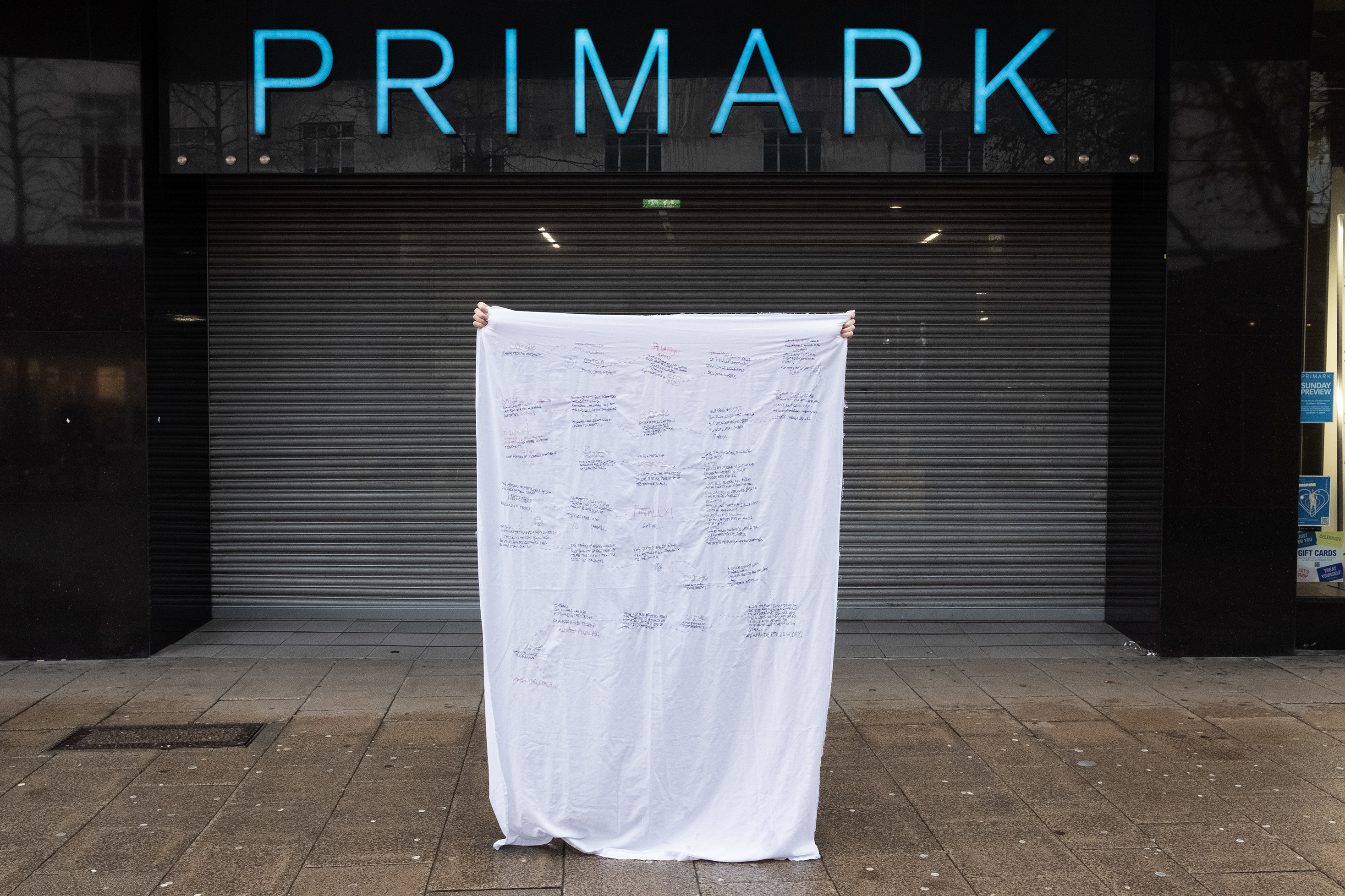
One might argue that companies unable to absorb such costs, should reconsider making products that require such a pricey end, and perhaps redesign the way their textiles are made all together.
My point is that even when legally enforced to ensure products are recycled, companies will still find a way to dodge, mislead, pass the buck and greenwash all those involved in the textile industry, including the consumer. Although I am not dismissing the fact someone must pay to safely recycle or dispose of our products, and that consumers should not contribute, this is a privileged, upper/middle class standpoint that not all can participate in. If many of the working class are unable to contribute financially to the recycling of their products, the likelihood is, they will be unable to purchase the product to begin with. Already we see this pattern in fast fashion; author Abigail Allan discusses climate change and the UK's working class, and responds to the suggestion that consumers should consider the quality of their items before purchasing, as a means to combat pollution. Allan states;
"In the cycle of poverty, the working class consumer cannot afford to buy a high-quality, and therefore expensive, pair of boots, and so is forced to constantly and frequently buy and replace cheap pairs of boots. Furthermore, in my own experience, poorer members of society are more likely to not be able to afford a car and its associated costs, or even public transport, and so will walk more often, often over longer distances, meaning our cheap shoes are likely to wear out even more quickly. Buying more expensive, higher quality items is an investment that pays off both ecologically and economically - but people who don’t have the spare income to invest in higher quality items are stuck with an alternative that is worse for both their financial situation, forcing them further into the cycle of poverty, and for the planet. This forces the consumer to buy more products more often, forcing them further into the cycle of poverty – and inevitably increasing their climate impact" (Allan, 2020: n/p).
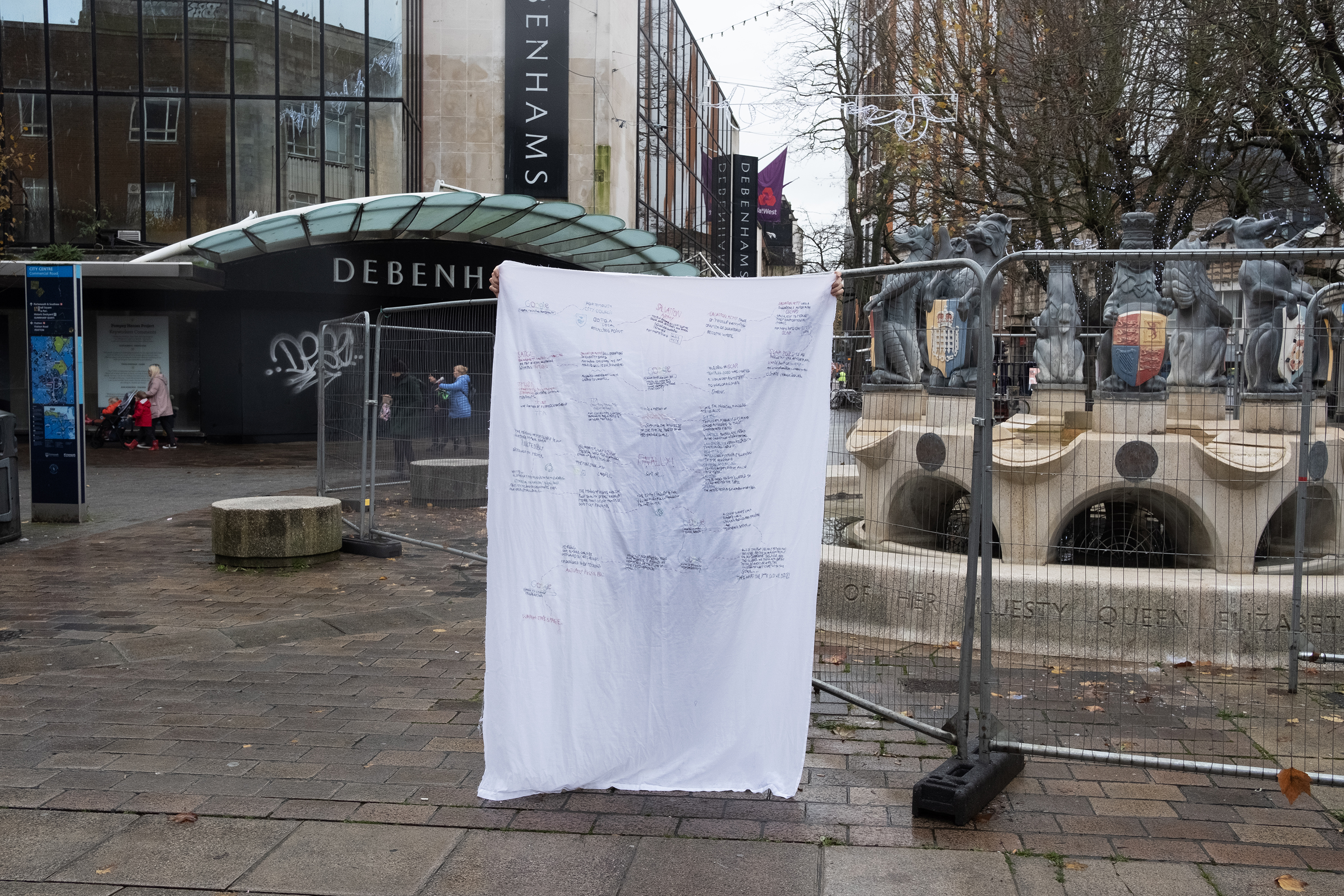
Without sociological context there is not a simple solution. Working class people may not have the option to avoid fast fashion, particularly with our current social crises. A non-consumerist approach to a circular economy may lead to class limitations and it would thereby suggest that the global industry need not create a complicated system, but scale back the current one; think necessity.
If production merely responded to need, as opposed to desire, the social, economical and environmental strain would be reduced enormously. In order for this sociological change, environmentalism must not exclude or target others. Author Jennifer Westerman reviews working class scholar and activist Karen Bell’s book; Working-Class Environmentalism: An Agenda for a Just and Fair Transition to Sustainability. In it,
“Bell calls on her readers and others to build a more inclusive environmentalism that will ‘benefit, include, and respect working-class people’ (p. 138). Learning from the environmentalism of the world’s poor efforts by trade unions to address environmental problems, and social movements for worker health and safety will enable a radical socio-ecological transformation. Bell asserts: ‘we must build alliances between social and environmental movements and extend these movements to support the widest scope of humans and ecologies possible'" (Westerman, 2021: 150).
As this issue is global, there is no quick fix or blanket solution that could possibly support everyone in the world. However it's with utmost importance that we stop the disempowerment and continuous beatings that the working class, Global South, and all others who are of a sociological and physical disadvantage, continually take.
If we are not careful, legislation change may replicate this pattern in different ways. We must ensure that there are no legislation loopholes that will allow companies to appear to be doing the right thing for the industry and our planet, but are in fact excluding many, whilst making no real change at all.
Legislation that ensures companies are responsible for a product's entire life cycle, must also ensure that what happens to the product is the same, regardless of who purchased it. Our current set up deliberately targets and blames those who are unable to participate any other way. There are of course exceptions to this; influencers and celebrities who don’t wear the same item twice, or the constant bombardment of social media and advertisers, desperately applying pressure for us to consume, consume, consume. I am not ignoring these facts, nor am I saying they are not incredibly problematic and detrimental to the way in which the industry is run. However I am saying that it is my belief that over time we can change these attitudes and behaviours for with them; comes choice.
I am standing for those that have no choice. The people in the Global South, the working class, the poor. I am standing for the workers in elastane factories becoming sick from the toxic chemicals, for the independent companies, scientists and researchers creating better ways to make and dispose of our products. For the protesters, artists and organisations shining light on this global unfairness and stating that enough is enough.
It is for these people and more, that I implore not just my government in the UK, but for governments around the world to stop this ludicrousness and make it simple. For that is the fix: simplicity.
Working class environmentalism provides the opportunity to consider everyone, of all backgrounds and abilities. Its impact on the textile industry would mean less items produced, better quality items, and transparency around recycling and a product's end of life.
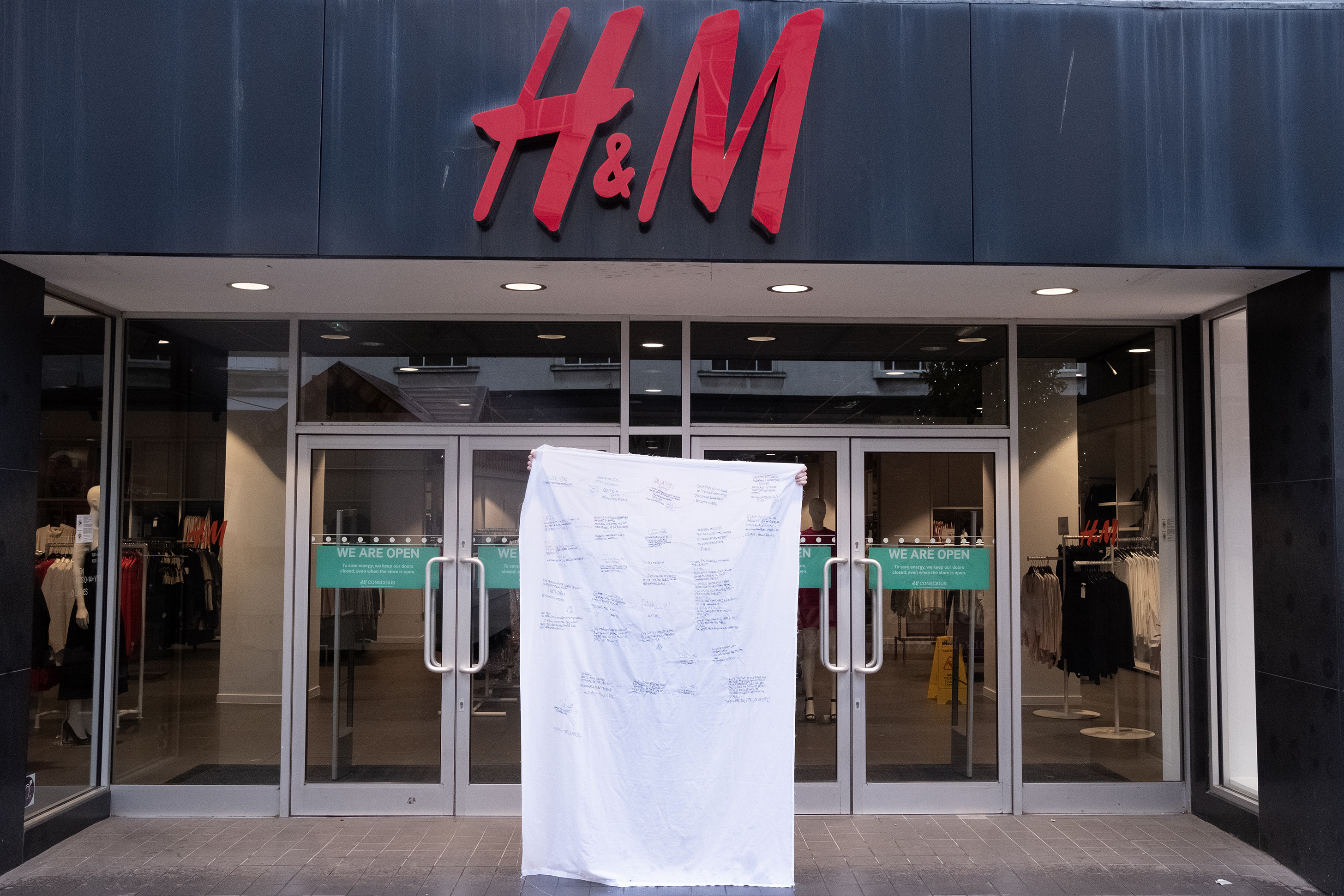
It is my belief that legislation change is the next step needed, to begin to make the global textile industry a much fairer, simpler place for all. However, my argument is that if you're a producer of a product, and the law states you are responsible for its entire life cycle, you must also be responsible for the interactions your product has with people and the landscape along the way. Is it sourced in a way that isn't detrimental to the land? Are the workers producing it being paid fairly and cared for? Are consumers buying an honest product without greenwashing? Can that consumer afford the time to repair? Is there a clear way to recycle? Can it go back to the land at the end of its life?
It is my belief that the law should recognise these interactions as responsibility, and producers should be held accountable. Not with fines, but with action, reprimand, and consequence. Without change the poor get poorer, the sick get sicker, and an unsustainable industry will continue to grow at the detriment to our planet.
It is important we shop second hand or from sustainably conscious and fair companies. It’s important that we reuse and repair our textiles, that we wear them more and wash them less. It’s important to avoid certain materials and read past the greenwashing, and it is important to donate and recycle our clothes. But not every option is possible for all, or easy to do, nor will any or all of those options combined change anything quickly. We need producers to take responsibility, and create a much simpler industry.
Perhaps the global textile industry may seem ambiguous, but in my campaign I intend to call out those responsible. I will fight for a fair legislation change, to ensure producers are held accountable. I will fight for better production, honesty and transparency, new technologies, and simplicity, and I ask you to stand with me in this fight where together we state that enough is enough.
I am campaigning for global change and I am fighting against global injustice.
Watch this space.
Allan, A, (2020) No Choice: Climate Change and the UK’s Working Class, [online] Accessed: 26.08.22. Available at: www.anthroposphere.co.uk.
Beton, A, Dias, D, Farrant, L, Gibo, T, Le, Y. Spain,G, (2014) Environmental improvement potential of textiles (IMPRO textiles), European commission, Joint Research Centre scientific and policy reports.
Bettin, L, (2021) Textile EPR recycling laws [online] Accessed: 10.11.22. Available at: www.ecommercegermany.com.
Connexion France, (2019) What is French eco participation fee and how does it work? [online] Accessed: 10.11.22. Available at: www.connexionfrance.com.
Westerman, J, (2021) A Review: Bell, K. (2020). Working-Class Environmentalism: An Agenda for a Just and Fair Transition to Sustainability.Journal of Working-Class Studies Volume 6 Issue 1.
Pascal Marcel Dreier
Theatrum Osteologicum (Theatre of Bones / Theatre of the Knowledge of Bones)
2022.
Theatrum Osteologicum is a lecture performance on bones, chimeras, and haunting. It is a summary of 15 months of research in London's waterways, museums, archives, and the artist's studio showing previously unpublished research material such as geophone field recordings and LIDAR-scans.
REFERENCES
Behringer, Richard R. ‘Human-Animal Chimeras in Biomedical Research’. Cell Stem Cell 1, no. 3 (September 2007): 259–62.
Berger, John. Why Look at Animals? Vol. 80. London: Penguin, 2009.
Chauveau, A. (Auguste), S. (Saturnin) Arloing, and George Fleming. The Comparative Anatomy of the Domesticated Animals.
New York : D. Appleton and Company, 549 & 551 Broadway, 1873.
Frandson, R. D. Anatomy and Physiology of Farm Animals. 2d ed. Philadelphia: Lea & Febiger, 1974.
Haraway, Donna. ‘The Promises of Monsters: A Regenerative Politics for Inappropriate/d Other’. In Cultural Studies, edited byLawrence Grossberg, Cary Nelson, and Paula Treichler, 0 ed. Routledge, 1991. .
Haraway, Donna Jeanne. Modest_Witness@Second_Millennium. FemaleMan_Meets_OncoMouse: Feminism and Technoscience. Second edition. New York, NY: Routledge, Taylor & Francis Group, 2018.
Hesiod, M. L. West, and Hesiod. Theogony: And, Works and Days. Oxford’s World’s Classics. Oxford ; New York: Oxford University Press, 2008.
Hsu, Der-jen, Chia-wei Lee, Wei-choung Tsai, and Yeh-chung Chien. ‘Essential and Toxic Metals in Animal Bone Broths’. Food & Nutrition Research 61, no. 1 (1 January 2017): 1347478. .
Kölliker, Albert von. Die normale Resorption des Knochengewebes und ihre Bedeutung für die Entstehung der typischen Knochenformen. Leipzig : F.C.W. Vogel, 1873.
Latour, Bruno. We Have Never Been Modern. Cambridge, Mass: Harvard University Press, 1993.
Le Guin, Ursula K. ‘A Left-Handed Commencement Address’. In Dancing at the Edge of the World: Thoughts on Words,
Women, Places, by Ursula K. Le Guin, 1st ed. New York: Grove Press, 1989.
———. ‘The Question I Get Asked Most Often’. In The Wave in the Mind: Talks and Essays on the Writer, the Reader, and the Imagination, by Ursula K. Le Guin, 1st ed. Boston : New York: Shambhala ; Distributed in the United States by Random House, 2004.
Martin, T John. ‘Historically Significant Events in the Discovery of RANK/RANKL/OPG’. World Journal of Orthopedics 4, no. 4 (2013): 186. .
Monro, J. A., R. Leon, and B. K. Puri. ‘The Risk of Lead Contamination in Bone Broth Diets’. Medical Hypotheses 80, no. 4 (1 April 2013): 389–90. .
Mylius, Johann Daniel. Philosophia Reformata Continens Libros Binos. Apud Lucam Iennis., typis vero Joannis Friderici Weissii, 1622.
Orlow, Uriel, Shela Sheikh, Showroom (Gallery), Switzerland) Corner College (Zurich, Parc Saint Léger--Centre d’art contemporain, and Kunste Halle Sankt Gallen. Theatrum Botanicum. Berlin: Sternberg Press, 2018.
Strydonck, Mark Van, Mathieu Boudin, and Guy De Mulder. ‘The Carbon Origin of Structural Carbonate in Bone Apatite of Cremated Bones’. Radiocarbon 52, no. 2 (2010): 578–86. .
Tajchman, Katarzyna, Aleksandra Ukalska-Jaruga, Marek Bogdaszewski, Monika Pecio, and Katarzyna Dziki-Michalska. ‘Accumulation of Toxic Elements in Bone and Bone Marrow of Deer Living in Various Ecosystems. A Case Study of Farmed and Wild-Living Deer’. Animals : An Open Access Journal from MDPI 10, no. 11 (19 November 2020): 2151. .
Vesalius, Andreas. De Humani Corporis Fabrica Libri Septem. Venetia, 1568.
FIGURES
- SEM bone, HA crystals and new bone. David Gregory & Debbie Marshall. Attribution 4.0 International (CC BY 4.0) Wellcome Collection, London.
- SEM of osteoporotic bone. David Gregory & Debbie Marshall. Attribution 4.0 International (CC BY 4.0) Wellcome Collection, London.
- Calcinatio, in: Mylius, Johann Daniel. Philosophia Reformata Continens Libros Binos. Apud Lucam Iennis., typis vero Joannis Friderici Weissii, 1622. 107.
- Putrefactio, in: Mylius, Johann Daniel. Philosophia Reformata Continens Libros Binos. Apud Lucam Iennis., typis vero Joannis Friderici Weissii, 1622. 117.
- William Blake, Cerberus (second version), 1824-1827, illustration for The Divine Comedy by Dante Alighieri (Inferno VI, 13-33), pen and ink and watercolour over black chalk and traces of pencil, 37.3 × 52.7 cm (sheet), London, England; National Gallery of Victoria, Melbourne.
- Vase of bone china painted with enamels and gilded, Spode Ceramic Works, Stoke-on-Trent, ca. 1820. Height: 26.9cm. One of a pair with C.710-1935. C.710A-1935
- Tafel II, in: Kölliker, Albert von. Die normale Resorption des Knochengewebes und ihre Bedeutung für die Entstehung der typischen Knochenformen. Leipzig : F.C.W. Vogel, 1873.
Volume 2
Introduction
Through the autumn of 2023, as the graduating cohort of the
MA Art & Ecology prepared their contributions to The Journal of Art
& Ecology, the necessity of linking ecology to questions of social
justice has seemed more urgent than ever. The work gathered here, by Aliansyah
Caniago, Sirun Chen, Rhiannon Hunter, Linnea Johnels, Jane Lawson, Sam Metz, Sohorab
Rabbey, Tina Ribarits, Elizabeth Salazar and Ella Wong, asks what it means to
be situated as an artist with a commitment to thinking and working ecologically
in the midst of planetary turbulence. At a time when settler-colonial violence, pollution and climate change denialism are surging, what artistic sensoria, tactics and
kinships might beckon towards more just and liveable forms of earthly life?
This 2023 edition of The Journal of Art & Ecology approaches dispossession and unfolding ecocide through sensorial memory, archival
investigation, material sensitivity and embodied knowledge. Much of the work makes
a critical challenge to the distancing techniques of extractivism and colonial
taxonomy, repurposing diagramming, mapping and digital capture to ask how we
might reconfigure our relations. The task of pluralising ecological knowledge
and attending to its historical omissions takes us into new methodological
territories – proposing autistic stimming as investigation, fungi as guides and
plants as healers of the cosmic body. Western epistemologies and capitalist
imperatives, which privilege certain kinds of bodies, are provincialized in
assemblages that combine the organic, the mineral and the technological, taking
their organisational logic from ancestral knowledge, acts of ecological care, Taoist
wisdom, neuroqueer phenomenology and decolonial feminism. In some contributions
the politics is outspoken, in others it appears as a haunting, in everyday
gestures of conviviality, or in quiet transgressions of translation. There are perspectives
that are tender and entangled, mournful and enraged, defiant and magical. It is
work that is not afraid to stumble through unfamiliar languages, to linger in
interstitial moments, to sit with discomfort and to recognise the radical
alterity of nonhuman creatures. It is art that is extending its antennae,
feeling its way towards deeper understandings of climate justice, mutuality and
recuperation.
Dr Ros Gray
Programme Director, MA Art & Ecology
Aliansyah Caniago










Rhiannon Hunter
assemblage - edit - collage - diffraction - story - cut - join - telling - anecdote - timespace - splice -
Reading [2 minutes 31 seconds]
Reading & Audio Visuals [4 minutes 28 seconds]
Reading & Audio Visuals [4 minutes 28 seconds]
1. Storying
To engage in land ecologies and conservation is to live with constant dilemmas around what and how decisions are made in the management of land, non-human and human beings, and what narratives are told and re-told.
Doings of Care works across different modalities of information gathering, transfer and narration and seeks to echo the multiplicity of engaging with urban nature spaces. Amid fragmentary moments, meaningful questions surface about kinship, conservation, care and acts of noticing.
Doing involves participating in bodily actions of touch and attunement with other entities and beings that creates opportunities for knowledge transfer. To observe someone walking in water in waders is different to wearing waders and feeling the water’s power, its agency against one’s own body.
Silt, pebbles, grind underneath my steadying foot, my hips twist as the cool power of the water embraces my outstretched calf to funnel with giddy ease between my waders. [1]
The process of filming and image capture both documents and severs action’s ties with a specific time-location, to reconstruct events in a film-time-space through storying. Recorded sound waves are thick with data about their production, of bodily exchanges between other beings, of seasonality and colliding temporalities. Audible bird calls, flying insects, snapping branches, digging, a droning aeroplane, a hissing boiling kettle are layered sonics that drift into each other and disrupt scale and linear sequential events.This disruption speaks of the indivisibility of time and space as it is formed through ‘co-generation’” [2](Vogelin, 2023, p.46). Sound’s storying speaks of the interconnectedness and liveliness of all beings vibrating as one sonic-soup.
The gist is the essence of something summarised for ease of recollection and translation. They are mobile, fragmented gifts of information that move linguistically from one mouth to the ear of another. In doing so, they are imbued with metadata – a time(stamp), location, author, lived experience - that link them to a moment – to a non-event-event taking place that is relational between social beings caught in exchange. Gists move as an autonomous common currency of sharing knowledge that can provide insights that enable one to orientate oneself within the complexity of experiencing environments. Gists can move as an anecdote that ‘as it circulates it shapes the ways in which particular incidents come to be understood' (Micheal, M, 2021, p25) [3] They are rebellious forms of sharing that create haphazard social bonds and unofficial networks of exchange that evade dominant structures of ordering information, people and living worlds for capital gain and commodification.
![]()
Doings of Care works across different modalities of information gathering, transfer and narration and seeks to echo the multiplicity of engaging with urban nature spaces. Amid fragmentary moments, meaningful questions surface about kinship, conservation, care and acts of noticing.
Doing involves participating in bodily actions of touch and attunement with other entities and beings that creates opportunities for knowledge transfer. To observe someone walking in water in waders is different to wearing waders and feeling the water’s power, its agency against one’s own body.
Silt, pebbles, grind underneath my steadying foot, my hips twist as the cool power of the water embraces my outstretched calf to funnel with giddy ease between my waders. [1]
The process of filming and image capture both documents and severs action’s ties with a specific time-location, to reconstruct events in a film-time-space through storying. Recorded sound waves are thick with data about their production, of bodily exchanges between other beings, of seasonality and colliding temporalities. Audible bird calls, flying insects, snapping branches, digging, a droning aeroplane, a hissing boiling kettle are layered sonics that drift into each other and disrupt scale and linear sequential events.This disruption speaks of the indivisibility of time and space as it is formed through ‘co-generation’” [2](Vogelin, 2023, p.46). Sound’s storying speaks of the interconnectedness and liveliness of all beings vibrating as one sonic-soup.
2. The ‘Gists of Things
The gist is the essence of something summarised for ease of recollection and translation. They are mobile, fragmented gifts of information that move linguistically from one mouth to the ear of another. In doing so, they are imbued with metadata – a time(stamp), location, author, lived experience - that link them to a moment – to a non-event-event taking place that is relational between social beings caught in exchange. Gists move as an autonomous common currency of sharing knowledge that can provide insights that enable one to orientate oneself within the complexity of experiencing environments. Gists can move as an anecdote that ‘as it circulates it shapes the ways in which particular incidents come to be understood' (Micheal, M, 2021, p25) [3] They are rebellious forms of sharing that create haphazard social bonds and unofficial networks of exchange that evade dominant structures of ordering information, people and living worlds for capital gain and commodification.
3. Care
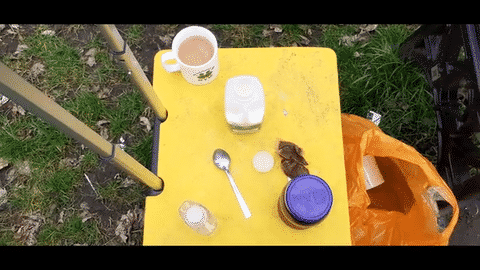
Care is not
‘nice, cozy relations’ [4] (Abrahamsson and Bertoni, 2014, cited in Puig de la Bellacasa, 2015, p707). To
care is radical. It is a mode of engagement with self, other, human and
non-human that operates and generates its own value system aside from dominant systems
of accumulation and endless growth. Care is the time it takes for - and to film
- gloved hands that dig earth to make a hole for a plant to take root.
![]()
To undertake care is to dedicate time to the process of maintenance, reproduction and the ‘creating liveable and lively worlds’ [5] (Puig de la Bellacasa, 2017, p.209) through everyday acts of doing, maintenance, noticing.
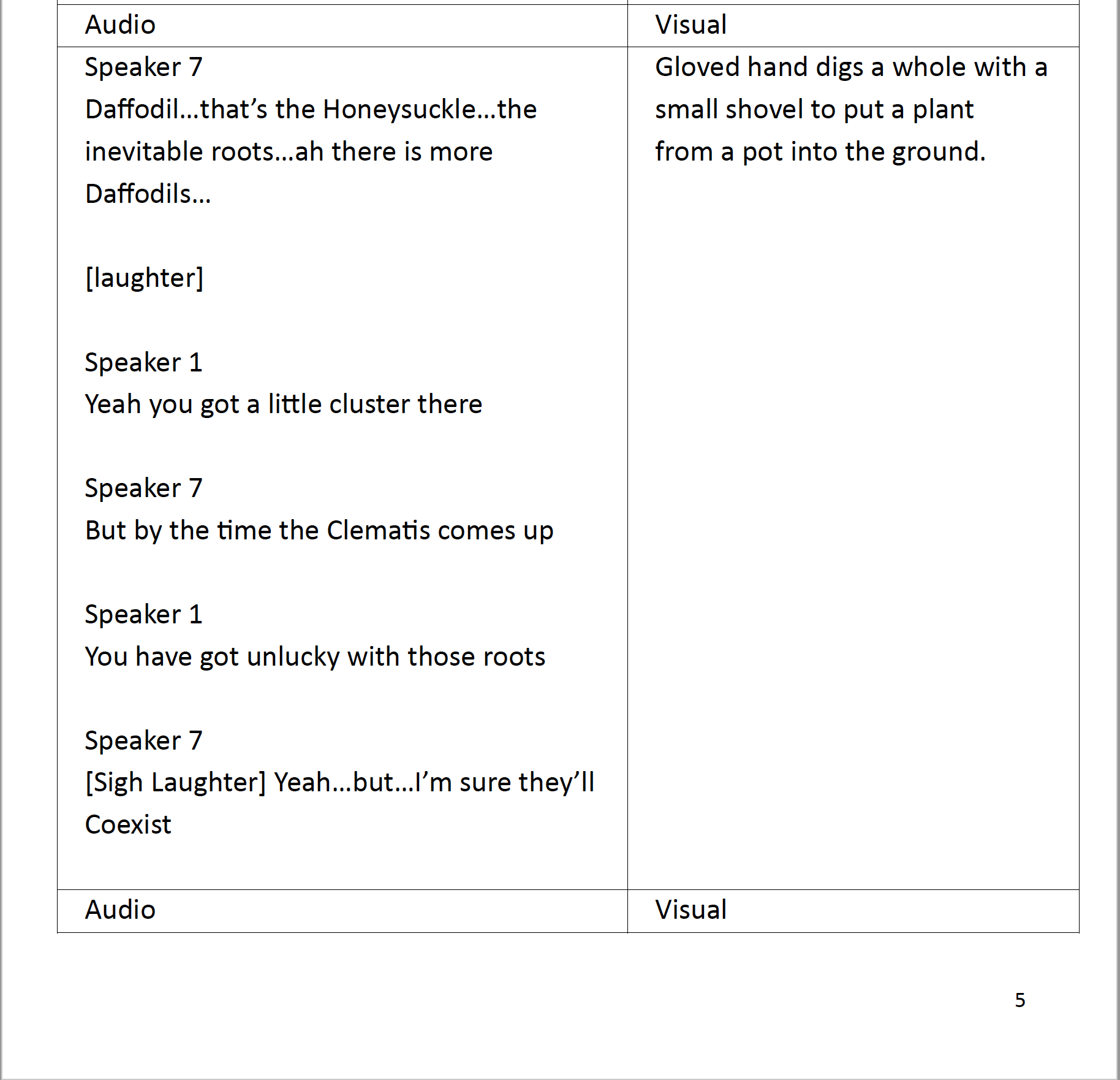
To undertake care is to dedicate time to the process of maintenance, reproduction and the ‘creating liveable and lively worlds’ [5] (Puig de la Bellacasa, 2017, p.209) through everyday acts of doing, maintenance, noticing.
I
too enter the thigh-high water and attempt to coordinate my arms, torso and
cutters to remove the reeds. The air is sulphurous from disturbed pond matter,
breath and ice hover in condensing clouds, an upturned snail shell bobs, bitter
tea and bourbon biscuits, chattered talk, with engine hums. Volunteers trickle
away in different directions. My tyres have left a line in the ice
crisped grass as I stop recording, feet numb, I leave the common for the
tarmac. [1]
![]()
[2] Voegelin, Salomé (2023). Uncurating sound: knowledge with voice and hands. New York: Bloomsbury Academic.
[3] Micheal, M. (2012), ‘Anecdote’ in Wakeford, N, and Lury, C (ed.), Inventive methods: the happening of the social,
[4]Puig de la Bellacasa, M. (2015). ‘In Making time for soil: Technoscientific futurity and the pace of care’, Social Studies of Science, Vol. 45(5) pp. 691–716. DOI: 10.1177/0306312715599851 sss.sagepub.com
[5]Puig de la Bellacasa, M. (2017). ‘Soil_Times_The_Pace_of_Ecological_Care’, Matters of Care: Speculative Ethics in More Than Human Worlds, Minnesota Press, pp.169-215>
De La Bellacasa, M, P. (2017) ‘Soil Times: The Pace of Ecological Care.’ Matters of Care: Speculative Ethics in More than Human Worlds, University of Minnesota Press, pp.169–216. JSTOR, Available: http://www.jstor.org/stable/10.5749/j.ctt1mmfspt.8. (Accessed: 19 Mar. 2023). Quote by Papadopoulos, Dimitris, 2011. “Alter-ontologies: Towards a Constituent Politics in Technoscience.” Social Studies of Science 41, no. 2: 177–201.
LaBelle, B. (2020), Sonic Agency Sound and Emergent Forms of Resistance, London, Goldsmiths Press.
Todd, Z., Kanngiesser, A. (2020), ‘Attending to Environment as Kin Studies’
From digital forum Constellations. Indigenous Contemporary Art from the Americas, Hyundai Tate Research Centre: Transnational and The Museo Universitario Arte Contemporáneo (MUAC), Available: https://muac.unam.mx/constelaciones/assets/docs/essay-kanngieser-and-todd.pdf(Accessed: 2022)

4. References
[1] Journal Entries
[2] Voegelin, Salomé (2023). Uncurating sound: knowledge with voice and hands. New York: Bloomsbury Academic.
[3] Micheal, M. (2012), ‘Anecdote’ in Wakeford, N, and Lury, C (ed.), Inventive methods: the happening of the social,
Routledge, p.25
[4]Puig de la Bellacasa, M. (2015). ‘In Making time for soil: Technoscientific futurity and the pace of care’, Social Studies of Science, Vol. 45(5) pp. 691–716. DOI: 10.1177/0306312715599851 sss.sagepub.com
[5]Puig de la Bellacasa, M. (2017). ‘Soil_Times_The_Pace_of_Ecological_Care’, Matters of Care: Speculative Ethics in More Than Human Worlds, Minnesota Press, pp.169-215>
Also
De La Bellacasa, M, P. (2017) ‘Soil Times: The Pace of Ecological Care.’ Matters of Care: Speculative Ethics in More than Human Worlds, University of Minnesota Press, pp.169–216. JSTOR, Available: http://www.jstor.org/stable/10.5749/j.ctt1mmfspt.8. (Accessed: 19 Mar. 2023). Quote by Papadopoulos, Dimitris, 2011. “Alter-ontologies: Towards a Constituent Politics in Technoscience.” Social Studies of Science 41, no. 2: 177–201.
LaBelle, B. (2020), Sonic Agency Sound and Emergent Forms of Resistance, London, Goldsmiths Press.
Todd, Z., Kanngiesser, A. (2020), ‘Attending to Environment as Kin Studies’
From digital forum Constellations. Indigenous Contemporary Art from the Americas, Hyundai Tate Research Centre: Transnational and The Museo Universitario Arte Contemporáneo (MUAC), Available: https://muac.unam.mx/constelaciones/assets/docs/essay-kanngieser-and-todd.pdf(Accessed: 2022)
